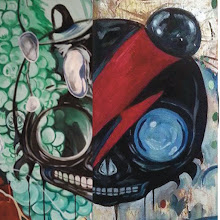"Dream of the Soft Cyborg (Performance Art) : "Explaining the world to a Hare," Pioneer Square, Seattle, WA . La Cocina. Rumor has it that this was the first night of all Latinx non-solo Performance Art in Seattle history--but who knows for certain. 2016.
This performance, like the earlier Spaniard performance at Anne Bonney in Seattle and a lost performance that I did at UCDavis all owed significantly to the performances of Joseph Beuys, whether I was aware of it or not. His mythology and mine overlapped in some very significant ways.
If I was somehow given the opportunity, I would love to work on a performance with Joseph Beuys--of all the artists throughout history--his is the one that I seem to come back to the most--visually, we share some striking similarities--which is odd--because for both of us the performance work is extremely personal, autobiographical and anecdotal. I'm sure that Beuys himself would say it has something to do with a kind of post-Jungian--artistic collective mind--but all of that is just a little too new agey for me--though I love Beuys for being so out there and for being so willing to go out on a limb for what he believed--no matter what!
As a child, before I even knew what art was, I would watch my father paint murals in the Los Angeles Chicano Art Movement as I would tag along to the Mechicano Art Center on Whittier Blvd mentally devouring the exciting scenes of Latino artists expressing what it meant to be Chicano back then! Days passed as I watched my father paint his expressionist, politically charged murals, day-dreaming of my own future. Every month my parents would take us to the LA Museums and galleries, where we saw Warhol's “Brillo Boxes,” conceptual sculptures and the films of Joseph Beuys and Gilbert and George. Later, in college, at the University of Nevada Reno and Uc Davis, my mind would be blown by the work of Marcel Duchamp and Dada, who influenced my now, mixed media performances.
It was during this time that I began to perceived an unspoken difference between how my heroes made art and how I--as a young Latino artist--was expected to. Let me tell you a story. As a young artist, I searched everywhere, for successful Chicano artists for a sense that my work had a place. When Duchamp or Beuys made their work it was about ideas, their ideas, it reflected their view of the world. No one asked Marcel Duchamp to make work that was solely about his heritage—and he did not have to make artwork for the annual Halloween exhibition, knowing that that was the only time he would be able to show his work. I desperately wanted to make art that had meaning beyond other's expectations—art that reflected my life! But I had no models, no history to fall back on. I decided that I would have to make my own.
Ultimately, At UCDavis, critical theory, personal history and personal artifacts began to infuse my work opening it up to incorporate queer, feminist and other identity discourses. I created two theoretical treatises, "The Soft Cyborg," a variation on Haraway's "Cyborg" and "Putoh"--melding Japanese Butoh and Latino identity performance.
Today, issues of gender, race and identity permeate my work and it is through performance that I seek to push the boundaries of how we perceive the essence of ethnic/cultural/Latinx performance, to give voice to underrepresented groups and, moreover, to expand the language of marginalized performance and even to broaden access through guerrilla and drop-in performances. . As a Latino Artist who works with many materials that have been pared down to their core elements, minimalized and purified so to speak--creating fiercely personal narratives--I have been forced to deal with oversimplified views of who can make what and what art can be made.
I am part of a new breed of Latinx artists intent on expanding the themes and expectations available to minority artists--making art that is individual--defying traditional expectations of collective identity. I choose personal, everyday materials, a collage of sheets, candy, fake flowers, tin foil and personal items in order to tell my stories. This is an important conceptual, performative and material shift that cannot be overstated. It is a stance of liberation, which pushes the boundaries of expectations and dares to say that individual lives of color matter; which, in itself, is powerful and revolutionary, problematizing racial, masculine, cultural and identity essentialism in an intellectual investigation which is in no way post-race.











No comments:
Post a Comment